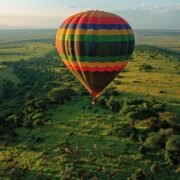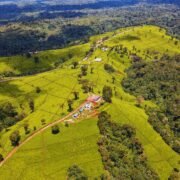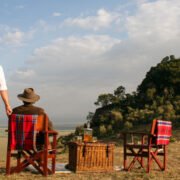
The Inspiring Story of Elsa the Lioness
Introduction to Elsa the Lioness
Elsa the Lioness is a name synonymous with wildlife conservation and the profound bond between humans and animals. Her story, popularized through the book and subsequent film “Born Free,” illustrates the delicate interplay of life in Africa’s ecosystems, particularly within the scenic landscapes of Meru National Park. Elsa gained recognition as not only a remarkable lioness but also as a beacon for conservationism, representing the challenges and triumphs of wildlife in a rapidly changing world.
Born into a world marked by conflict, Elsa was orphaned at a young age after her mother was hunted. The chances of survival for such a young lioness in the wild would usually be slim. However, her extraordinary journey began when she was adopted by Joy and George Adamson, who dedicated their lives to introducing her back into her natural habitat. This act of rehabilitation not only showcased the depths of human empathy but also emphasized the importance of fostering robust wildlife populations in their native environments.
As she grew, Elsa transformed from a playful cub to a magnificent lioness, embodying both grace and strength. Her life in the wild was filled with the challenges of survival, yet she thrived, becoming a pivotal figure in educating the world about the importance of protecting vulnerable species. The essence of her legacy is embodied in initiatives such as the Meru Rhino Sanctuary and other conservation projects within Meru National Park, which are crucial for preserving biodiversity in this unique corner of Kenya. Elsa’s story serves as a foundation for understanding the broader context of wildlife conservation in the region, guiding those interested in exploring off-the-beaten-path safaris in Kenya and seeking encounters with the Big Five. Her journey emphasizes the significance of preserving these remote Kenya safari destinations for future generations.
The Background of Elsa’s Story
Elsa the lioness is a symbol of compassion and human-animal relationships, with her story rooted in the early 1950s when she was born in the wilds of Kenya. Her origins are intricately tied to the hands of conservationist and author Joy Adamson, who found her as a cub after the death of her mother. Baby lions, like Elsa, face myriad challenges in the wild, including competition for food, threats from larger predators, and the harsh realities of their natural habitat. The statistics are daunting, as the survival rate for lion cubs is generally low due to these threats.
Raised in Meru National Park, her journey highlighted the delicate balance of nature and the impact of human involvement. Joy Adamson took on the responsibility of nurturing Elsa, aiming to give her a fighting chance in a world often hostile to young predators. This unique experience is documented in the well-known book ‘Born Free’, which has inspired wildlife conservation efforts globally. Adamson’s innovative approach combined both emotional and practical lessons, showcasing how humans can positively influence the survival of wildlife. Her dedication enabled Elsa to experience both love and the skills necessary for survival, embodying the core philosophy of ‘Born Free’ which promotes the preservation of wild animals in their natural habitats.
Elsa’s legacy continues, prompting interest in off-the-beaten-path safaris in Kenya, particularly in Meru National Park and the neighboring Kora National Park. These remote Kenya safari destinations offer visitors rich landscapes and wildlife experiences, including opportunities to observe the Big Five. Moreover, the Meru Rhino Sanctuary supports ongoing conservation and serves as one of the best places to see rhinos in Kenya. The narrative of Elsa not only enlightens individuals about one remarkable lioness but also accentuates the broader initiatives in place to protect various species within the tranquil yet challenging settings of the Kenyan wilderness.
Elsa’s Human Companions
Elias and Joy Adamson were pivotal figures in the life of Elsa the Lioness, whose story captured hearts around the world. The Adamsons, passionate wildlife conservationists, devoted themselves to caring for Elsa after they found her abandoned as a cub. This nurturing relationship laid the groundwork for an extraordinary bond between a wild animal and humans, showcasing the profound connections that can develop in the heart of Meru National Park, one of Kenya’s less conventional wildlife havens.
Joy Adamson, in particular, is often credited with understanding and advocating for the needs of Elsa. Through her insightful observations in the vast wilderness, Joy provided the care and companionship that this young lioness required. Her dedication included feeding Elsa and training her to thrive in the wild while fostering a strong emotional connection. The Adamsons documented this journey through their writings and photographs, which have since inspired countless individuals to engage with nature and wildlife conservation.
The Adamson family’s approach to raising Elsa not only emphasized her natural instincts but also highlighted the importance of understanding wildlife for peaceful cohabitation. This relationship became a beacon of hope in the fight against declining lion populations, and it illuminated the potential for human-animal bonds amidst the beautiful backdrop of Meru National Park, a destination celebrated for its unique biodiversity and remote allure.
As Elsa grew into adulthood, the Adamsons made it their mission to help her transition to life in the wild, a testament to their commitment to wildlife. This journey encapsulated not only the resilience of Elsa but also the challenges faced in remote Kenya safari destinations, including the Meru Rhino Sanctuary. The legacy of Elsa the Lioness continues to resonate, inspiring visitors to Meru and Kora sister parks to appreciate the delicate balance of wildlife preservation amid the magnificent landscapes of Kenya.
Elsa’s Rehabilitation and Release into the Wild
The rehabilitation of Elsa the Lioness was a meticulous and emotional journey led by Joy Adamson, who strived to prepare her for a life in the wild. Captured as a cub in 1956, Elsa was initially raised in captivity and formed a deep bond with Adamson, who dedicated herself to teaching Elsa the necessary survival skills for life in Meru National Park. This process was not without its challenges; training a young lioness to hunt, avoid dangers, and socialize with other wildlife requires patience and expertise.
Adamson employed various strategies to educate Elsa. Regular interactions with her in a semi-wild environment of the Meru Rhino Sanctuary allowed Elsa to gradually reconnect with her instincts. Teaching her how to stalk and capture prey was a paramount component of her training, and Adamson would often enact scenarios to simulate realistic hunting experiences. This hands-on approach not only facilitated the development of Elsa’s technique but also encouraged her natural behaviors, essentials for survival in the rugged terrain of remote Kenya safari destinations.
As Elsa’s skills flourished, the emotional weight of her eventual release into the wild loomed large. Adamson created an environment where Elsa could explore independently, making her first attempts at hunting on her own. The day she was finally released was bittersweet and marked a pivotal moment in conservation history. Elsa the Lioness became a symbol of wildlife rehabilitation and served as an inspiration for off-the-beaten-path safaris in Kenya that prioritize the well-being of animals. Her story continues to emphasize the importance of rehabilitation and the possibility of co-existing with wildlife in their natural habitats, especially in rich locations like the Meru and Kora sister parks. The successful release of Elsa demonstrated not only her strength but also the potential for remarkable transformations in wildlife conservation efforts throughout Kenya.
The Impact of Elsa’s Return to the Wild
The story of Elsa the lioness remains one of the most compelling accounts in wildlife conservation, particularly regarding her successful return to the wild. After being raised by Joy Adamson and her husband, Elsa underwent a significant adaptation phase when she was reintroduced into Meru National Park. This transition was crucial not only for Elsa but also for understanding broader conservation themes and social dynamics among wildlife.
Elsa’s integration into the forest marked a significant achievement in wildlife rehabilitation, especially for a species that faces mounting pressures from habitat loss and poaching. While adapting to her surroundings, Elsa demonstrated her natural behaviors, providing vital insights into her species’ social structures and daily survival skills. Observers noted her interactions with local wildlife, highlighting her successful acclimatization to the ecosystem she was originally a part of.
The implications of Elsa’s release extended far beyond her individual journey. It served as a powerful symbol for conservation efforts within Meru National Park and other off-the-beaten-path safaris in Kenya. The narrative of her return demonstrated the potential for human interventions to foster positive outcomes in wildlife rehabilitation. This success story has encouraged various stakeholders, from wildlife conservation organizations to resort operators, to invest more in initiatives that support remote Kenya safari destinations like Meru and Kora sister parks.
Moreover, Elsa contributed to the larger understanding of human-wildlife relationships. Her story has provoked dialogue on the necessity of protecting natural habitats, particularly in areas like the Meru Rhino Sanctuary, where conservation efforts focus on safeguarding endangered species. Elsa’s legacy reminds us of the delicate balance required to coexist with wildlife and preserves areas in northern Kenya, which are among the best places to see rhinos in Kenya. Thus, Elsa’s return propelled significant discussions around wildlife conservation and reshaped perceptions surrounding efforts towards the protection of the African wilderness.
Cultural Legacy and Media Representation
Elsa the Lioness has profoundly impacted societal attitudes towards wildlife conservation and animal rights through both the book “Born Free” and its subsequent film adaptation. These works chronicled the extraordinary journey of Elsa, a lioness raised by conservationists Joy and George Adamson, and have created a meaningful narrative around the bond between humans and wildlife. The story not only captured hearts worldwide but also served as a catalyst for wildlife conservation efforts, particularly in regions like Meru National Park, where Elsa was reintroduced to the wild. This area, known for its rich biodiversity and being part of the meru and kora sister parks, became synonymous with conservation initiatives aimed at protecting the Big Five and the fragile ecosystem.
The publication of “Born Free” introduced readers to the challenges faced by wildlife, particularly in remote Kenya safari destinations, where habitats are often under threat from human encroachment. By showcasing the beauty and vulnerabilities of creatures such as lions, the narrative influenced public understanding and perception of species that are frequently misunderstood. This transformation in public consciousness has fueled interest in touristic activities such as the 3-day Kenya safari package, which allows visitors to witness the magnificence of animals in their natural habitats, promoting a greater appreciation of wildlife. The media representation of Elsa not only humanized animals but also provided a powerful platform for discussing urgent conservation issues, heightening awareness around species like the rhinoceros.
Moreover, the legacy of Elsa exemplifies the significance of off-the-beaten-path safaris in Kenya, which provide unique opportunities for visitors to connect with nature. Areas like the Meru Rhino Sanctuary, sought after for their successful conservation programs, highlight the efforts taken to protect endangered species and bolster pride in Kenya’s natural heritage. The enduring message of “Born Free” remains relevant today, inspiring new generations to engage in conservation efforts and cherish the rich wildlife found in Kenya’s diverse national parks.
Lessons Learned from Elsa’s Journey
The story of Elsa the Lioness serves as a profound reminder of the vital lessons in compassion, the necessity of wildlife conservation, and the deep interconnectedness between humans and animals. Elsa was not only a symbol of resilience but also a catalyst for change, inspiring countless individuals to advocate for wildlife protection, particularly in remote Kenya safari destinations like Meru National Park.
One of the most compelling lessons from Elsa’s journey is the importance of empathy towards all living beings. Her story highlighted the unique bond that can form between humans and wildlife, demonstrating how mutual understanding can lead to successful rehabilitation and eventual reintegration into their natural habitats. This theme is particularly relevant in discussions around off-the-beaten-path safaris in Kenya, where visitors can witness firsthand the significance of protecting these majestic creatures amidst the encroachment of human development.
Furthermore, Elsa’s experiences underscore the critical need for wildlife conservation. In places like Meru Rhino Sanctuary, efforts to safeguard endangered species reflect the lessons learned from Elsa’s narrative. Educating the public about conservation initiatives not only fosters respect for wildlife but also encourages proactive involvement in preserving ecosystems. This is especially significant in the context of big five safari Kenya tours, where many visitors are motivated to participate in conservation efforts within protected areas.
Ultimately, Elsa the Lioness’s journey exemplifies the impact one individual can have on broader wildlife conservation movements. It reminds us that each action counts, whether through advocacy or direct engagement in conservation activities. As the story of Elsa continues to resonate, it contributes to a growing awareness of the numerous challenges faced by wildlife and the essential role human stewardship plays in ensuring a sustainable future for all species.
Current Status of Wildlife Conservation Efforts
Wildlife conservation remains an essential undertaking, particularly in regions like Kenya, where biodiversity is at risk due to human activities and climate change. The legacy of iconic figures such as Elsa the lioness continues to inspire current conservation endeavors, highlighting the intrinsic link between wildlife preservation and community involvement. Today, numerous initiatives are focused on protecting endangered species, such as the lions whose populations have seen alarming declines over recent decades, paralleling the earlier plight of Elsa.
The scope of modern conservation efforts encompasses expansive projects like the Meru National Park safari, which serve not only as preserves for wildlife but also as vital ecosystems that support the broader environment. These areas act as refuges for endangered species, including the elusive rhinos found in the Meru Rhino Sanctuary, one of the best places to see rhinos in Kenya. However, the challenges remain daunting, with habitat loss and poaching threatening the survival of the Big Five in Kenya, alongside a range of other wildlife species.
Additionally, off-the-beaten-path safaris in Kenya tap into under-visited wildlife areas, promoting sustainable tourism that benefits local communities while ensuring the safety and survival of wildlife. Collaborative efforts between NGOs, government agencies, and local populations are crucial in raising awareness about conservation, especially in remote Kenya safari destinations like the Meru and Kora Sister Parks. These partnerships strive to engage the public in wildlife preservation efforts, allowing them to contribute through education and responsible tourism practices.
Despite the progress made, ongoing support and action are necessary to address existing threats. The enduring story of Elsa the lioness serves as a reminder of the importance of preserving wildlife for future generations, underscoring that every effort to protect endangered species counts in the grand tapestry of conservation.
Conclusion: The Enduring Spirit of Elsa the Lioness
The story of Elsa the Lioness transcends generations, serving as a powerful testament to the enduring spirit of wildlife conservation. Elsa’s journey, immortalized in the book and film “Born Free,” has illuminated the incredible bond between humans and animals and underscored the significance of protecting our natural world. The Meru National Park, where Elsa was raised, has become synonymous with her legacy and continues to be a destination for travelers seeking to understand the beauty and fragility of wildlife. Those embarking on a 3-day Kenya safari package often find themselves captivated by the stunning landscapes and wildlife, including the rare species found in the Meru Rhino Sanctuary.
Elsa’s life symbolizes the persistent struggle against poaching and habitat loss, underscoring the need for ongoing conservation efforts. As we reflect on her story, it becomes clear that every action counts in the fight to preserve wildlife. For enthusiasts of big five safaris in Kenya, recognizing the interconnectedness of all species is vital. Elsa’s tale serves as an inspiring reminder that safeguarding habitats and species, including rhinos, is essential for future generations.
Visitors to remote Kenya safari destinations can appreciate the value of off-the-beaten-path safaris in Kenya, where the spirit of Elsa, along with her compatriots in the Meru and Kora sister parks, continues to thrive. Her legacy encourages a commitment to preserving these areas, which not only host wildlife but also embody the essence of nature’s resilience. By engaging with Elsa’s story, we invite all readers to join the movement to protect the natural world, ensuring that her spirit and the beauty of wildlife remain alive for years to come.






